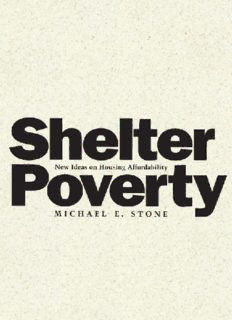
Shelter Poverty: New Ideas on Housing Affordability PDF
Preview Shelter Poverty: New Ideas on Housing Affordability
Shelter Poverty Shelter Poverty New Ideas on Housing Affordabili ty Michael E. Stone Temple University Press Philadelphia Temple University Press, Philadelphia 19122 Copyright © 1993 by Michael E. Stone. All rights reserved Published 1993 Printed in the United States of America The paper used in this publication meets the minimum requirements of American National Standard for Information Sciences Permanence of Paper for Printed Library Materials, ANSI Z39.48-1984 @J Library of Congress Cataloging-in-Publication Data Stone, Michael Eric, 1942- Shelter poverty: new ideas on housing affordability / by Michael E. Stone. p. cm. Includes bibliographical references and index. ISBN 1-56639-050-8 (cloth: alk. paper). - ISBN 1-56639-092-3 (pbk.: alk. paper) 1. Housing-United States. 2. Housing-United States Finance. 3. Housing-United States-History. 4. Poor Housing-United States-Finance. 5. Housing policy-United States. 6. Public welfare-United States. I. Title. HD7287.96.U6S76 1993 363.5 '83 '0973-dc20 92-32768 Portions of Chapters 2 and 5 are adapted and updated from One-Third of a Nation: A New Look at Housing Affordability in America, by Michael E. Stone. Copyright 1990, Economic Policy Institute. Used by permission. For Ursula, Erik, and Caleb. Thanks for your love, your support, your indulgence, and your endurance. Contents Acknowledgments ix Introduction 1 Part I What Is Shelter Poverty? 1 Human Needs and Housing Affordability 13 2 The Shelter-Poverty Concept of Affordability 32 Part II Why Does Shelter Poverty Exist and Persist? 3 The Historical Roots of the Affordability Problem to the Early 1930s 61 4 The Triumph and Illusions of Housing Policy and the Economy, 1930-1970 91 5 Economic Crisis, Shelter Poverty, and Housing Programs, 1970 to the Early 1990s 126 8 The Instability of Housing Production and Finance Since the Late 1960s 163 viii Contents Part III How Can Shelter Poverty Be Overcome? 7 Social Ownership 191 8 Financing and Implementing Social Ownership 218 9 Housing Reform with a Vision: Ownership and Production 235 10 Housing Reform with a Vision: Financing and Other Elements 258 11 Housing Affordability and Social Change 277 12 Conclusion: Shelter Poverty and the Right to Housing 310 Appendix A. Methods and Issues in Deriving the Shelter-Poverty Affordability Standard 323 Appendix B. Determining the Extent and Distribution of Housing Affordability Problems: Methodological Comments 345 Appendix C. Tables of Shelter Poverty and Conventional Affordability Problems, 1970-1991 351 Notes 361 References 391 Index 417 Acknowledgments Ts book;s the culn,;",,,;on of ove< two decades of research, policy development, and advocacy on housing affordability. My engagement as a housing activist and interest in housing organizing as a potential vehicle for social change began when I was working for the Model Cities Program in Trenton, New Jersey, in the late 1960s. I first came to understand the centrality of mortgage lending to the housing problem, and the primary concern of housing policy with the interests of lending institutions and the financial markets, through a paper I wrote for a course on planning theory and the modern capitalist state at the Massachusetts Institute of Technology in 1971. I conceptualized the shel ter-poverty concept of affordability in 1972 while I was working at Urban Planning Aid, an advocacy planning organization in Massachusetts. And I initially formulated a program for non-speculative social provision and capital-grant financing of housing in a paper presented at a conference at the Institute for Policy Studies in Washington in 1973. Over the intervening decades my ideas have been developed, elabo rated, refined, revised, and tempered in the light of personal experience, historical change, and, most especially, interaction with many perceptive and helpful people. Some I have worked closely with over a long period of time. Some have participated with me on task forces and working groups. Some have provided useful challenges, feedback, and suggestions through individual meetings, correspondence, or phone conversations. Unfor-
Description: